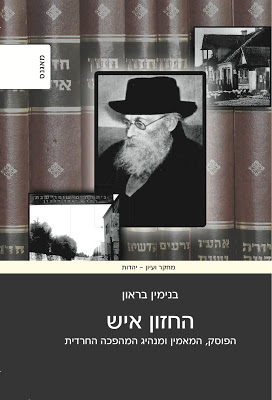Pashkevilin and Benny Brown’s New Book on The Hazon Ish
Following the internal self-destructive collapse of the proverbial ghetto walls within Jewish communities around the world, the actual walls of Jerusalem continue to be adorned with elaborate pashkevilin, broadsides, and as The Satmar Rebbe, the late Reb Yoel Teitelbaum, zy”a, once allegedly offered a deep philosophical preach: ‘Meah Shearim is sustained by the pashkevilin on her walls.’ Recent scholarship on these broadsides has been offered by Benjamin Brown, “The Socio-Religious Texture of the Meah Shearim Neighborhood,” Ariel: A Periodical for the Study of Eretz Israel 163-164 (March 2004): 121-135 (Hebrew); and on the origins of these broadsides, see Menachem Friedman, “The Pashqevil (Pasquinade) and Public Wall Poster/Bulletin Board Announcements in Haredi Society,” in Broadsides: Wall Announcements and Polemical Proclamations in the Haredi Street (Jerusalem: Ben Zvi Institute, 2005), 8-37 (Hebrew).
As noted by OnTheMainLine blog, a recent article in Haaretz, offered some background on the recent digitisation of more than 20,000 pashkevilin from a private collection in Jerusalem (under the curatorship of Mr. Yoel Krois of The Edah Charedis). To access the digitised broadsides hosted by the The National Library of Israel (at Givat Ram), see here. The ranking collection of pashkevilin actually housed in an academic setting is at The Widener Library of Harvard University, whose indefatigable Judaica librarian, Dr. Charles Berlin of the Harvard College Library, has spent decades securing copies of pashkevilin from Jerusalem. In addition, The JTS Library has thousands of broadsides within their holdings, described here.
But with the new collection of (what I’ve dubbed) ‘The Edah Charedis Collection,’ see here, Hebrew school teachers and other Jewish educators will be able to assign broadsides to students interested in perfecting their own writing skills, from the lost-art of flowery Hebrew writing. It’ll be like taking a walking trip down the winding roads of Meah Shearim, just without the rugelach, kiggel, or bags of popcorn, among other amenities of traversing the roads of Meah Shearim! The significance of these pashkevilin cannot be overstated. Scholars around the world now have a literal window into the religious imagination of the religious leadership of Meah Shearim of the past century, and from the comfort (not to mention security!) of their own home!
But as significant and exciting that twentieth-century pashkevilin are for future generations of scholars and scholarship, for many in the Jewish book world, the mere appearance of a broadside has often been the cause for consternation and anxiety for any author. Excommunications and other taunts have been immortalized during an individual’s fifteen minutes of fame, though these are often extended due to the shedding pashkevilin on the walls of Meah Shearim. One pashkevil observer once mentioned to me that the most controversial pashkevilin are often posted in the final moments after candle-lighting in Jerusalem, ensuring a 25-hour window before being defaced. Mi Ke-Amcha Yisrael!
In any event, my thoughts and fears about pashkevilin resurfaced following the publication this morning of a volume that offers the first-ever book-length academic look at Rabbi Abraham Isaiah Karelitz zt”l, widely known as The Hazon Ish, at the founding of a modern Haredi community in the State of Israel, and is a significant contribution towards the study of Orthodox Judaism and religious life in the Land of Israel during the twentieth-century. And it is nearly 1,000 pages. Yes, my friends, this is the book that we’ve all been waiting for. I am so happy to announce: Benjamin Brown, The Hazon Ish: Halakhist, Believer and Leader of the Haredi Revolution (Jerusalem: Hebrew University Magnes Press, 2011; Hebrew), co-published by The Center for Jewish Law and Contemporary Civilization at Benjamin N. Cardozo School of Law, Yeshiva University, under the directorship of Prof. Suzanne Stone. (Plans are underway for an English translation of this work; please let me know if you wish to assist in sponsorship.)
Copies of Benjamin Brown, The Hazon Ish: Halakhist, Believer and Leader of the Haredi Revolution (Jerusalem: Hebrew University Magnes Press, 2011; Hebrew), are available for purchase at Shavua Sefer in Jerusalem and at bookstores around Israel. For overseas customers, copies are also available at a special rate, with proceeds to support the efforts of the the Seforim blog. Please contact Eliezer Brodt (EliezerBrodt@gmail.com), co-editor of the Seforim blog; also, follow us on Twitter (@theSeforimblog). While I am still waiting to hear how many copies will be for sale at The Steimatzky in Bnei Brak, if you are interested in purchasing this volume, I strongly urge you to let us know as soon as possible, as Benjamin Brown, The Hazon Ish: Halakhist, Believer and Leader of the Haredi Revolution (Jerusalem: Hebrew University Magnes Press, 2011; Hebrew), is going to be the hottest-selling academic book this year….so purchase soon!
See here for the cover of Benjamin Brown, The Hazon Ish: Halakhist, Believer and Leader of the Haredi Revolution (Jerusalem: Hebrew University Magnes Press, 2011; Hebrew), as well as the volume’s ToC, prologue, and English abstract.
Operators are standing by…
